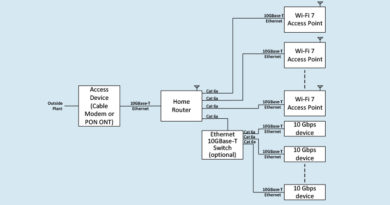Multi-Gig Broadband in Brownfield MDUs
By Steven Nesbitt
The most adept network developers quickly recognize that they cannot ignore key areas for expansion simply because they are challenging to access or navigate.
The same wisdom is applicable to cable operators and communications service providers (CSPs). Their fiber access network build-outs invariably pass many brownfield multiple-dwelling units (MDUs), each one full of subscribers looking for the latest high-speed broadband services. Despite this, providers often ignore these customer-dense buildings. Why? Usually, it’s because the legacy copper cabling networks typical in brownfield MDUs are not capable of supporting multi-gigabit broadband services, and upgrading the cabling infrastructure in MDUs can be complex, expensive and time-consuming.
Is this really a significant issue for network operators?
Consider that roughly 50 million families, or about one in three households in the United States and Canada live in MDU properties. About 80% of all MDUs were built prior to 2000, and these buildings were typically cabled with UTP and/or coax copper network infrastructure. This means that some 40 million potential broadband subscriber households currently live in brownfield MDUs cabled with legacy copper networks. This is a significant portion of the available market, and it’s clear that service providers simply cannot afford to ignore these potential customers when they come within reach of the fiber access network.
Essential advice for CSPs
If the limiting factor in offering multi-gigabit broadband in brownfield MDUs is the performance envelope of the existing copper networks, then providers must take aim at improving those performance limitations. Fortunately, providers can apply the latest fiber extension technologies to legacy copper MDU cabling plants, enabling multi-gigabit broadband service delivery to subscribers anywhere in the property. Fiber-extension-over-copper is a win for subscribers and providers alike.
Two fiber extension technologies to consider
For cable operators, the ‘MoCA Access 2.5’ fiber extension technology standardized by the Multimedia over Coax Alliance allows MAC data rates up to 2.5 Gbps downlink and 2.0 Gbps uplink, with latency less than 5 ms latency over legacy in-building coax networks. MoCA can co-exist on the same coax infrastructure with legacy services including cable/terrestrial/satellite TV and DOCSIS, allowing operators to offer multiple services in the same MDU while providing a migration path to FTTH.
For CSPs, G.fast fiber extension technology allows delivery of gigabit broadband services to subscribers in brownfield MDUs over legacy twisted-pair and coax copper cabling plants. With XGS-PON in the access network, a single MDU ONU typically delivers enough bandwidth to serve the entire building with G.fast, providing subscribers with the same gigabit downlink/uplink speeds and low-latency experience as full FTTH customers.
The bottom line for cable operators and CSPs in MDU properties
Delivering gigabit broadband services to subscribers in MDU properties is critical to maximizing revenues and ROI for service providers building out their FTTH networks. For greenfield MDU projects, FTTP is the preferred infrastructure solution, especially now as new fiber cabling systems engineered specifically for rapid deployment in MDU properties enter the market. For brownfield MDUs, service providers should employ fiber extension technologies that enable multi-gigabit service delivery over legacy copper infrastructure. Bypassing brownfield MDUs without providing high-speed services leaves that property underserved, making it vulnerable to competitive threats from both wireline and fixed wireless access competitors.
Steven Nesbitt,
Director of Sales,
North America
Wirewerks
Steven is a business professional with a decade of experience in the telecommunications industry. Each of those years has been in a variety of professional capacities ranging from managing small regional territories and now directing the sales operations for North America. He has worked with leading telecommunications companies and has extensive knowledge of the latest trends and technologies in the market. Steven’s expertise includes network architecture, infrastructure design, and project management. He is passionate about developing long-term business relationships to connect people and transform businesses.




